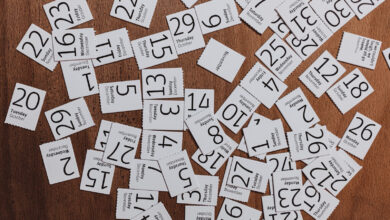Harnessing the Power of Calendars for Effective Budgeting and Financial Planning

If you thought calendars were only for tracking dates and scheduling appointments, think again! One of the most effective, yet underrated tools for budgeting and financial planning is perhaps already hanging on your wall or resting on your desk – your calendar. With a systematic approach and a dash of discipline, you can transform this everyday item into a powerful ally in managing your personal finances. Here’s how:
1. Monthly Income and Expense Tracking:
One of the most fundamental aspects of managing personal finances is having a clear understanding of your income and expenses. This is where your calendar becomes an invaluable tool.
Start by marking your payday(s) on the calendar, highlighting the date you receive your salary. If you have multiple sources of income, mark all the dates when you receive these payments. This gives you a clear view of when money will be entering your account, and how much.
Next, you should detail your fixed monthly expenses. These are payments that don’t change from month to month, such as your rent or mortgage, utilities, mobile phone bills, internet, and any debt repayments. For each of these, mark the date the payment is due on the calendar. If the payment is automatic, it’s still worth marking the date so you can ensure you have sufficient funds in your account to cover it.
Don’t forget to account for regular variable expenses, such as groceries, fuel, and dining out. Estimate the cost and designate specific dates for these expenses as well.
By visually mapping out your income and expenses on your calendar, you create a timeline of your cash flow. This allows you to see at a glance when and where your money is coming from and going to. It also allows you to spot any potential ‘danger days’ where multiple bills are due at once, giving you the opportunity to reschedule payments or set aside funds in advance.
This comprehensive view of your financial situation sets the groundwork for more effective budgeting, helping you avoid overspending and late payments, and ultimately leading to better financial health.
2. Planning for Bills and Expenses
While monthly bills and routine expenses take a regular slot in our financial planning, it’s often the large, infrequent expenses that can disrupt our budgets the most. These costs might include annual insurance premiums, vehicle maintenance, home repairs, or even holiday spending. Since these costs don’t appear in our budget every month, they’re easy to forget about until they’re upon us.
This is where proactive planning and your trusty calendar come in. Here’s how to use your calendar to prepare for these bigger, less frequent bills and expenses:
Firstly, make a list of all the significant expenses you anticipate for the year. The key word here is ‘anticipate’. We can often predict most of these costs, even if we don’t know the exact amounts. These could be things like a major appliance needing replacement, or your car needing its annual service.
Once you have your list, estimate when these expenses will occur and how much they’ll likely be. Then, go to your calendar and mark these expenses on the appropriate dates. If you don’t have a specific date, placing them in the month they’re likely to occur is a good start.
Now, take a look at your calendar and the big expenses scattered throughout the year. This gives you foresight, allowing you to prepare for these costs instead of being surprised by them. For example, if you know a large bill is due in six months, you can set aside a portion of your income each month to ensure you have the funds ready when the bill arrives.
Taking the time to forecast these larger expenses and marking them on your calendar helps you spread the cost over time. This approach makes these expenses feel less daunting, prevents them from derailing your monthly budget, and contributes significantly towards maintaining financial stability.
3. Setting Savings Goals
Saving can often feel like a challenging task, but breaking it down into manageable, regular amounts can make it significantly more achievable. Using your calendar to set and track savings goals can provide both a clear path and regular motivation.
First, determine what you’re saving for. Is it a holiday, a new car, a down payment for a house, or an emergency fund? Once you’ve identified your goal, write down how much money you’ll need to reach it.
Next, decide when you want to achieve this goal. Be realistic in considering your income and other financial commitments. Once you’ve got your target date, mark it on your calendar. This serves as your finish line.
Now, work backwards from your goal date to determine how much you need to save each month. For example, if you want to save £1200 for a holiday in 12 months’ time, you’ll need to save £100 each month. Mark this monthly savings target on your calendar as a regular reminder of your goal.
Having these savings goals visually represented on your calendar can serve as a powerful motivator. Each month, when you see you’re a step closer to your goal, you’ll feel a sense of achievement, which can encourage you to stay the course.
In addition, marking these goals on your calendar allows you to factor them into your monthly budget, making sure that your saving plan aligns with your income and expenses.
Whether your savings goal is small or large, short-term or long-term, your calendar can be a vital tool in planning, tracking, and ultimately achieving it. By breaking your goal down into regular, manageable amounts and marking these on your calendar, you can turn the daunting task of saving money into a manageable, and even enjoyable, endeavour.
4. Debt Repayment
Debt can often seem like a daunting mountain to climb, but with a structured approach and the strategic use of your calendar, it can be systematically managed and ultimately paid off.
Firstly, it’s essential to understand the full picture of your debt. List all your debts, including the amount you owe, the interest rate, and the payment due date for each. Once you have this overview, you can start to develop a repayment strategy.
One common approach is the ‘snowball method’, where you focus on paying off the smallest debt first while maintaining minimum payments on the rest. Once the smallest debt is paid off, you then apply that payment to the next smallest debt, and so on. Conversely, the ‘avalanche method’ involves paying off the debt with the highest interest rate first.
Regardless of the strategy you choose, your calendar is a crucial tool in your debt repayment plan. Mark each debt’s payment due date on the calendar to ensure timely payments, avoiding late fees and additional interest. If you’re using the snowball or avalanche method, you can also mark the date when you expect each debt to be paid off. This can serve as a motivator, showing the light at the end of the tunnel.
Another way to use your calendar in debt repayment is to plan for additional payments. If you receive a bonus, a tax refund, or have an extra paycheck in a month, mark these on your calendar and plan to use them for additional debt payments. This can significantly accelerate your debt repayment and save you on interest.
Paying off debt requires commitment and discipline, but it can be made manageable with a clear plan and the use of a calendar to track progress. Seeing your debt decrease over time on your calendar can provide a sense of achievement and control over your financial situation.
5. Regular Financial Reviews
Conducting regular financial reviews is vital to maintaining healthy finances. It’s an opportunity to check your financial status, ensure you’re on track with your goals, and make any necessary adjustments to your budget or savings plan. Your calendar is the perfect tool to schedule and keep track of these reviews.
Firstly, decide how frequently you want to review your finances. Monthly reviews are commonly recommended, as they align with most bill cycles and pay schedules. However, you could also consider weekly reviews if you’re actively trying to curb your spending or pay off debt.
Once you’ve determined the frequency, mark these review dates on your calendar. Treat these like any other important appointment – something you shouldn’t skip unless absolutely necessary.
During these financial reviews, take a look at your income and expenses. Are you staying within your budget? Are there areas where you consistently overspend? Are you able to save as much as you planned? This is the time to scrutinise your spending habits and make changes if necessary.
Also, assess your progress towards your financial goals. Are you on track to meet your savings targets? How is your debt repayment going? Seeing the progress you’re making towards these goals can be rewarding and motivating.
Lastly, remember that your financial plan isn’t set in stone. It should evolve as your life and financial situation change. Regular reviews allow you to adjust your plan based on changes in your income, expenses, or financial goals.
Scheduling regular financial reviews and marking them on your calendar can help you stay in control of your finances. It ensures you regularly check in with your financial status and habits, allowing you to make informed decisions and stay on track with your financial goals.
6. Reminder of Tax Deadlines
Tax time can be stressful, but by being organised and proactive, you can minimise that stress and potentially even save money. A great way to do this is by marking important tax dates on your calendar.
Begin with the tax filing deadline. In the UK, the deadline to submit your self-assessment tax return online and pay the tax you owe is typically January 31st. Mark this on your calendar as the absolute last day to complete your tax duties.
However, it’s not advisable to wait until this date to start preparing. Instead, set an earlier personal deadline to complete your tax return. This gives you enough time to gather necessary information, fill out forms accurately, and resolve any issues that might arise.
In addition to the filing deadline, there may be other important tax dates to note. If you make advance payments towards your tax bill – known as ‘payments on account’ – these are usually due by January 31st and July 31st. Again, mark these on your calendar.
Moreover, if you’re self-employed or run a small business, you may need to pay VAT or Corporation Tax. These have different deadlines, so make sure you know when they are and mark them on your calendar.
By noting these dates on your calendar, you not only ensure you meet your tax obligations on time, but also spread out the workload, making it more manageable. Regular reminders can prevent tax time from becoming a last-minute scramble and help you avoid penalties for late submission or payment.
Proactive planning and a marked-up calendar are some of the simplest ways to make tax time less stressful and more efficient. Remember, being organised with your taxes isn’t just about meeting deadlines; it’s also a crucial part of managing your finances effectively.
7. Noting Financial Milestones
One of the key aspects of managing your finances is to track your progress. Financial milestones are a great way to do this. They help you to stay focused, motivated, and celebrate the success of your financial journey. Here’s how you can use your calendar to note and celebrate these milestones.
First, identify what your financial milestones are. These could include saving a certain amount of money, paying off a specific debt, or reaching a particular net worth. They should align with your financial goals and be realistic, measurable, and time-bound.
Once you’ve identified these milestones, estimate when you expect to achieve them and mark these dates on your calendar. This gives you something concrete to work towards and allows you to visually track your progress.
For example, if one of your goals is to save £5,000 for a holiday, and you’re able to save £500 a month, you should achieve your goal in 10 months. Mark this date on your calendar and then each month, track how much you’ve saved. This regular tracking and the visual representation of your progress can keep you motivated and focused.
Once you’ve reached a milestone, it’s important to take a moment to celebrate it. This doesn’t have to involve a lavish celebration or expensive rewards. It could be as simple as a special meal, an evening out, or even just taking the time to acknowledge your achievement and how far you’ve come.
Using your calendar to note and celebrate your financial milestones not only makes managing your finances more rewarding but also encourages you to stay on track and focused on your goals. This simple practice can transform your approach to financial management from a daunting task into a rewarding journey.
8. Future Planning
Financial planning isn’t just about managing your current income and expenses – it’s also about preparing for the future. Using your calendar can be a great way to plan for long-term financial goals and commitments. Here’s how you can do this.
Start by identifying your long-term financial goals. These could include saving for retirement, buying a house, funding a child’s education, or building a sizeable emergency fund. These goals are typically several years away and require consistent saving and investment over a long period.
Once you’ve identified these goals, estimate when you want to achieve them and how much you’ll need. Then, work out how much you’ll need to save or invest each month or year to reach these goals by your target date.
Mark these long-term goals on your calendar, along with the regular savings or investments you’ll make towards them. Treat these like any other regular financial commitment. This visual representation of your long-term goals can provide motivation and make them feel more concrete.
In addition, use your calendar to plan for financial commitments that may not be monthly but are predictable. This could include annual insurance premiums, car servicing, or property taxes. By noting these on your calendar, you can plan and save for them in advance, avoiding a last-minute financial stress.
Lastly, remember that future planning involves regularly reviewing and updating your goals and plans. As your financial situation changes, your plans may need to be adjusted. Regular financial reviews, marked on your calendar, can help ensure your future planning remains aligned with your current situation and future aspirations.
Using a calendar for future planning can turn abstract, long-term goals into tangible, achievable targets. It not only helps you visualise your path towards these goals but also ensures you’re regularly saving or investing towards them, making your financial future more secure.
Conclusion
By integrating your calendar into your financial routine, you not only organise your financial life but also gain a broader perspective on your income, expenses, and financial goals. So why wait? Grab that calendar and start your journey towards financial wellness today!





